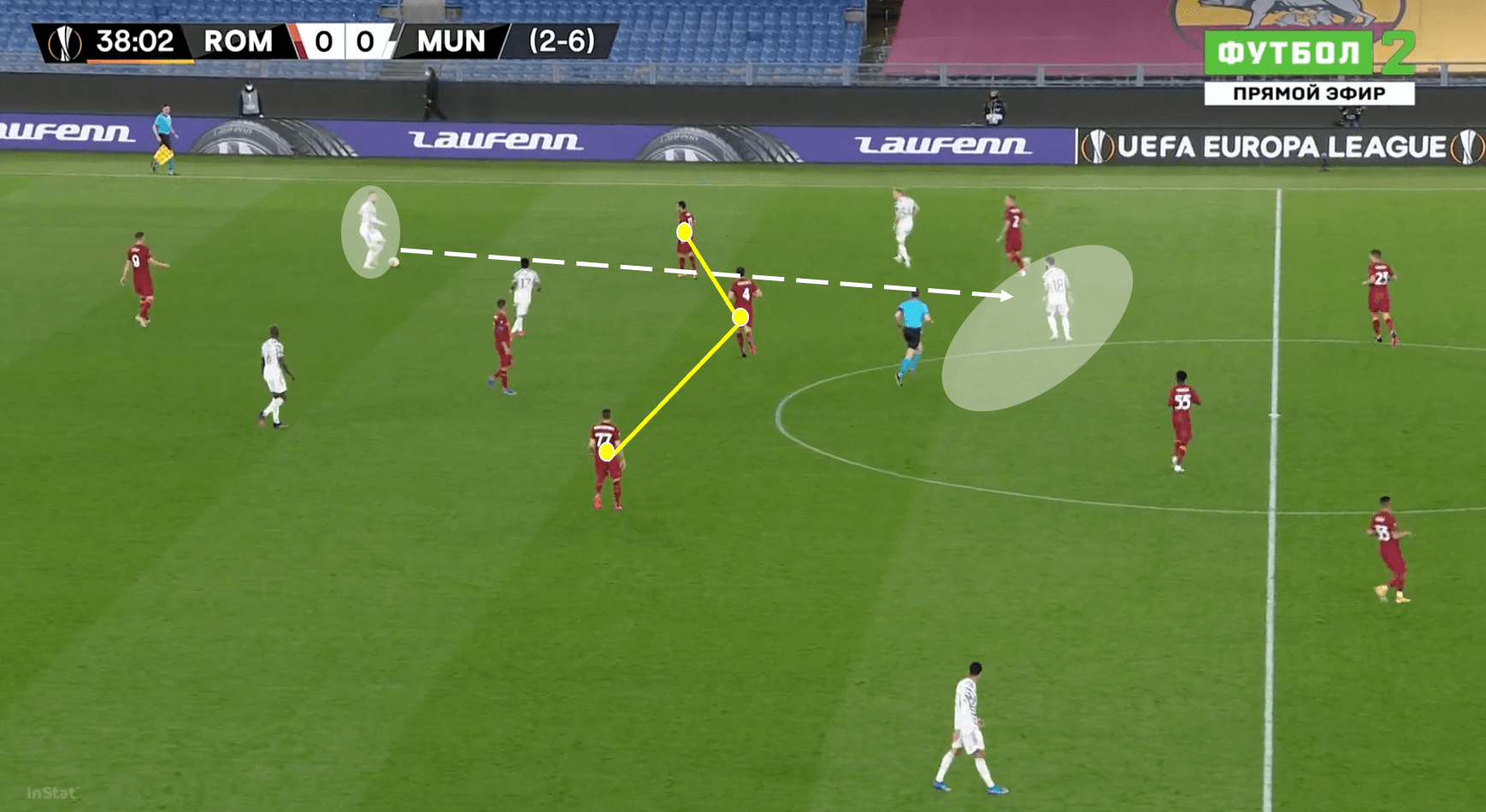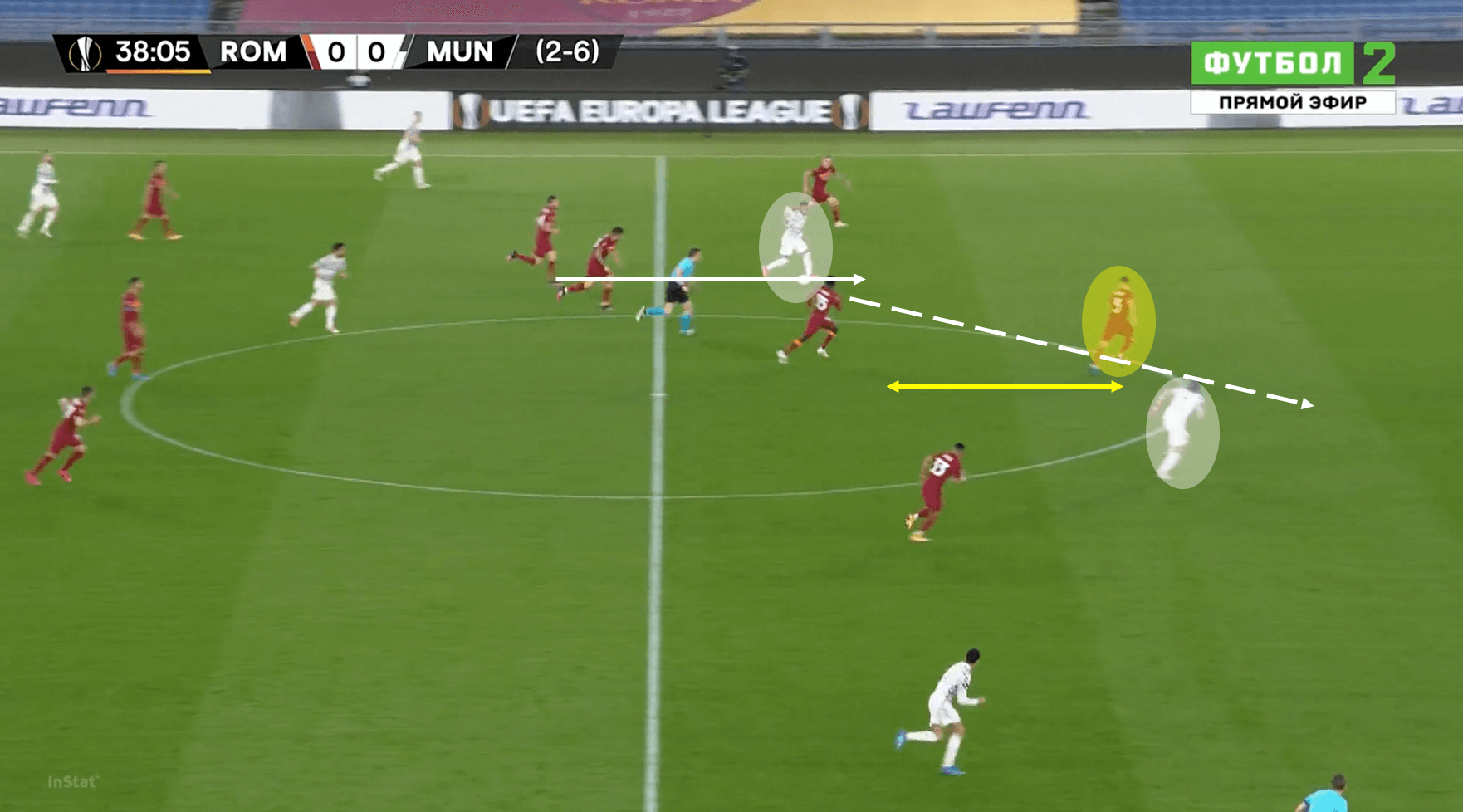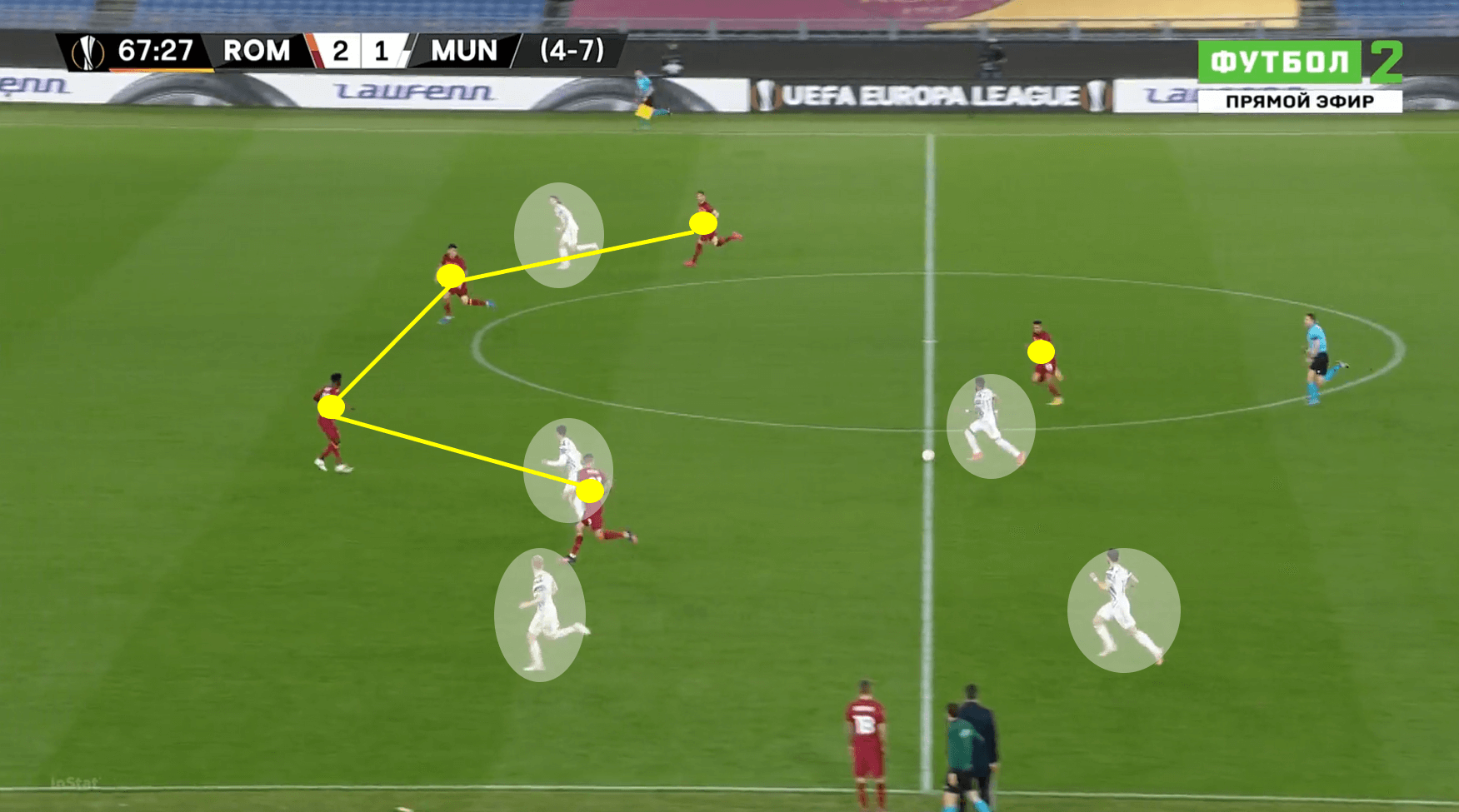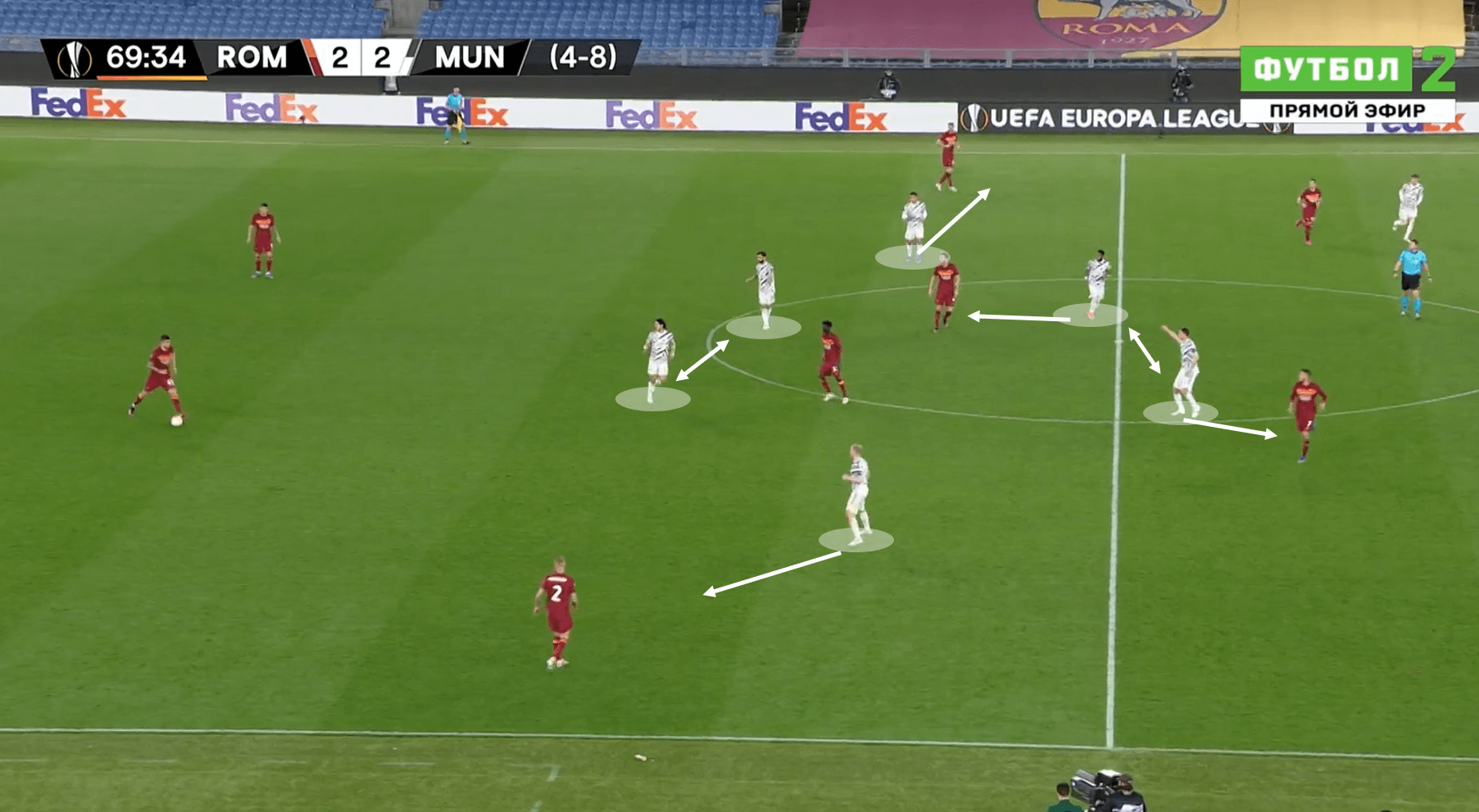Despite the first leg of this Europa League semi-final being dominated by Manchester United in an emphatic 6-2 victory over Roma, the Italians still put up a fight in the second leg to produce an enthralling tie. While both sides have enjoyed differing fortunes in their respective league campaigns in the Premier League and Serie A, the Europa League remained as the only chance of silverware for either club and it is now one step closer to being in the hands of Manchester United. This tactical analysis will provide an insight into how Roma approached the game with a sense of fearlessness due to the harrowing aggregate score going into the second leg – they ultimately had nothing to lose. We will also look at how Manchester United responded with goals of their own, and how they looked to stifle any hope of a Rome comeback.
Lineups

Hosts Roma deployed a 4-1-4-1 system, with the hope of finding a productive balance between controlling the midfield danger from United and posing a threat going forward themselves. Experienced striker Edin Džeko led the line, with wide support coming from Pedro and Henrikh Mkhitaryan. Centrally, Bryan Cristante partnered Lorenzo Pellegrini in the more advanced midfield roles, with Gianluca Mancini sitting as the anchor. Former United defender Chris Smalling lined up alongside Ibañez in the heart of the defence.
Ole Gunnar Solskjaer set his side up in the shape of a 4-2-3-1, with Edinson Cavani playing as the lone striker. Mason Greenwood, Donny van de Beek and Bruno Fernandes operated as the advanced midfield unit, with the first two taking occupation on the flanks from time to time. Defensive support in midfield was provided by Paul Pogba, who also had to licence to contribute in attack, and Fred. Luke Shaw and Aaron Wan-Bissaka were at full-backs with Harry Maguire and Eric Bailly in the middle of defence.
Resilient Roma
As we will uncover later in this analysis, Roma had their issues when defending in their own half. However, they showed positive signs in their work both on and off the ball in Man United’s half, especially in the early stages of the game.

United’s slow approach to play out from the back was slow and located deep in their half, which surely acted as triggers for Roma to close the gap and apply pressure in dangerous areas of the pitch. After a number of Roma midfielders were further up the pitch, pressure was applied to the man on the ball, forcing United to give the ball away – all of their passing options were marked and the man on the ball was pressed also. A smart way for Roma to kick off this game: if they were to have any chance of a comeback, unsettling Man United had to be the top priority in the early stages.

Here, we see Roma in an attacking transition after United were forced into a turnover in possession. Instead of looking to hold possession and establish firm control over the match, Roma would look to hit United on the break, with runners in several positions. Dzeko, although now blessed with pace, showed clever movement to occupy one of the center-halves each time Roma performed a counterattack – he would often be a pivotal piece of the attacking puzzle once his side reached the penalty area.

As we have seen on a number of occasions this campaign, Manchester United are not the most comfortable team when pressure is applied onto them, particularly in tricky situations like this one, in their own box. As Fred looks to meet a loose ball after a ricochet off of Maguire, United seemed to lack a real urgency in getting the ball away from danger. Fred performed a clever turn to beat his first challenger, only to be met by a supporting Roma midfielder in Pellegrini. Once taking the ball away from Fred, he found his midfield partner Cristante, who fired a rocket into the back of the net. This was a wake-up call for United, and another demonstration of how Roma wanted to win the ball back as soon as a trigger became apparent, and how they instantly looked to attack once they won the ball back.
How United survived the comeback threat
While Roma never really got too close to troubling Manchester United, in terms of the aggregate score at least, Solskjaer’s men needed to establish their dominance in the game to ensure Roma don’t add more pressure onto them. United were able to take advantage of some poor Roma defending to unlock the Italian’s backline to grab a goal, while their defensive setup made it very difficult for Roma to build dangerous attacks in situations that weren’t quick and aggressive breaks.

United’s first goal was a very clever one, with Bruno Fernandes proving his quality once again. The best players do the tiny details consistently and to a high standard, and that is exactly what Fernandes did here. Recognising that Roma were simply in a poor defensive shape, he occupied that space, enabling him to receive the ball and drive the attack forward. From a Roma perspective, their midfield unit seemed to have little awareness and communication, and their positioning was just not good enough – the majority of the Roma midfielders in the shot are offering nothing to the defensive set-up.

This move culminated in Fred making a good overlapping run for Fernandes, receiving the ball under little pressure as Roma failed to react to their initial defensive set-up. From there, the Italian side’s problems only grew. For some bizarre reason, one defender (Darboe) is far deeper than any of his teammates, leaving a huge space to be exploited by Cavani. With Fred in a dangerous position and a big space with an experienced striker at the ready, the Brazilian midfielder unleashed a pass into the path of Cavani, who took the ball through before smashing it home to give his side the lead. This goal coming just before half time will have also killed some of the momentum that Roma built during the first half.

As the game went on, and Roma took the lead (on the night), understandably they got a little caught up in the hope of the comeback and immediately committed men to the attack. While Roma had a back four in a strong shape, narrow and compact to try and limit United’s chance of getting through on goal in a central area, the lack of a Roma midfield allowed the Premier League side to essentially bypass the midfield third, giving them a chance of a dangerous attack. Once they approached the final third, they slowed the attack slightly, showing some patience as their attacking options took up better positions. The attack ended with nice cross which was met by another good Cavani run for United’s second goal.

With a four-goal advantage and around 20 minutes on the clock remaining, Manchester United realised that there was no real need to attempt quick and aggressive attacks, or to apply high amounts of pressure off the ball. However, they didn’t always just simply sit deep and look to defend their box, they often looked to stifle Roma’s possession before they even got out of their own defensive third. Matic and Fred worked well together defensive in situations like this, with very little distance between them, making it virtually impossible for passes to get through them. Cavani would also often drop deeper to join this mid-block, lining up alongside Fernandes, where the pair would perform a similar role to the Fred/Matic role. This compact set-up basically eliminated the central threat to Roma, making it extremely difficult to reach their attacking focal point in Dzeko.
Conclusion
The nature of this tie (due to the aggregate score going into the game) allowed for a free-flowing match, almost an exhibition. While Roma clearly have flaws in their game, with a squad that requires improvements, they showed little signs of being nervous or feeling the pressure in this second leg. Their pressing work caused trouble for Manchester United, particularly early on, while their ability in a counterattack is what gave them life. Manchester United reacted well enough to Roma’s attacking danger – winning the game on the night would only have been a bonus for United, but they were well aware that avoiding a big defeat would confirm their place in the final. Their defensive work was admirable in spots, but they showed there is still work to be done in possession, particularly when they’re in their own half and under some pressure.






Comments